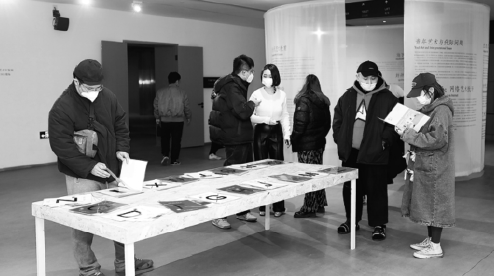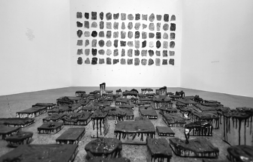
Artist Gao Lei's painting, Iris, depicts the skeleton of a stranded blue whale, exhibited at the Natural History Museum in London. It's one of the works on show at The Exhibition of Annual of Contemporary Art of China 2021.

Yu Aijun's sculpture from the Rooftop series.

Visitors to the show at Beijing's 798 Art Center.

A sculpture by 30-year-old artist Yang Yang, Beyond Human Control.

Jiang Bo's sculpture series, Who Am I, consists of 40 hand-shaped sculptures.

From left: Performance artist Tong Wenmin's video, Torch, in which she uses her body as a medium to "talk" with nature; Brushstroke by Wu Jian'an; and visitors are attracted to Chen Huafeng's installation, which is inspired by an overturned stove.

Though contemporary artists in China have been confronted with lots of challenges and difficulties caused by the pandemic over the past few years, they have still kept active and productive. A show based on 2,891 art exhibitions held in 2021 offers a comprehensive overview of the recent development and condition of contemporary art in China.
The show, The Exhibition of Annual of Contemporary Art of China 2021, is held at Beijing's 798 Art Center and Shanghai's Duolun Museum of Modern Art. Works by 26 established artists are on display in Beijing while those of 12 artists, many of whom are young, are exhibited in Shanghai.
Zhu Qingsheng, curator of the exhibition, says that it's "a dynamic demonstration" of the book Annual of Contemporary Art of China 2021 published last year by the Chinese Modern Art Archive of Peking University, an art institution that has recorded the progress and development of Chinese contemporary art since 1986. Since 2015, an exhibition based on the book has been held annually.
"Contemporary art is about critical thinking and a reflection of society. Contemporary artists try to find solutions to problems facing us. The show is an exploration of that," says Zhu, who is also chairman of the International Association of Art History.
The show covers 12 key themes, and top of that list is art and technology.
According to the Annual of Contemporary Art of China 2021, The hottest topic in 2021 was non-fungible tokens, digital assets, including images and video clips, which are represented by unique codes and secured using blockchain technology. The technology can track the ownership and validity of each NFT when it is bought or sold.
In 2021, when digital artist Mike Winkelmann, known as Beeple, took the art world by storm after his NFT, titled Everydays: The First 5,000 Days, sold for more than $69 million at an auction at Christie's, Chinese artists warmly embraced the new art form. Shows and sessions based on NFT-related topics were thus widely organized. Several digital art auctions were also held in Beijing and Shanghai.
Apart from blockchain, artificial intelligence, biological science, materials science and other cutting-edge technologies are employed by artists to create artworks, writes the Annual.
Zhu, the curator, says that one of the latest developments in contemporary art is its active combination with technology. Science's characteristics of change and innovation are converging with art.
"In fact, contemporary art has always been a lab of creativity," he says.
The Annual notes that artists should remain wary of advanced technology when actively embracing these new sciences. Many works on display reflect the artists' feeling surrounding such issues.
Artist Ding Shiwei concentrates on exploring the relationship between people and their screens, as well as the definition of what is real and virtual. When visitors get within a meter of the works in the 34-year-old's series Aesthetic Distance — comprised of circular screens featuring popular facial emojis — the features on the emojis will collapse.
Art collective Slime Engine presents a video installation, Extreme Live, at the show. Three big phone-shaped screens livestream a digital avatar selling goods by employing different promotional skills to attract as many potential buyers as possible in a virtual wilderness. The Shanghai-based art group, consisting of several young artists, has been utilizing the digital space since 2017, with different projects that manipulate people's understanding of physical space.
Artist Liang Shaoji buries various cell phones with shimmering and sparkling white silk threads in his installation Stranded from his Snow Cover series.
"Mobile phones become indispensable to us. It seems that only via mobile phones can we gain a sense of existence and maintain communication with the outside world. However, a large amount of fake information keeps us unsettled," says the 78-year-old, who raises silkworms and has used silk threads throughout his artistic career.
Liang wishes that people would spend more time in the real world, instead of being immersed in cyberspace and dominated by things like mobile phones, tablets and computers.
A total of 111 representative artists were included in the name list of the Annual. They were selected through extensive surveys, research of 3,850 documentary sources, and analysis of related data. Almost all of them held shows at art museums in 2021.
Among the names, there are established artists who gained fame during the last century, such as Cai Guoqiang, Liu Xiaodong and Fang Lijun. Many young artists, born in the 1980s and 1990s, are also included in the list.
"China has experienced great changes in the past four decades. The younger generation is very different from that of their parents. Such differences are distinctive in their artworks," says Zhu, adding that the show reflects an intergenerational shift in the exploration of Chinese art in 2021.
The past few years have seen more and more young artists in their 20s and 30s emerging. They are active across online platforms, which show their works and are supported by galleries, art museums and art institutions, enabling them to be exposed to a wider audience.
Zhu says that artistic concepts of Chinese artists are fully in line with their global counterparts. The younger generation is facing a world that brings more challenges and opportunities, as contemporary Chinese art is gradually integrated into that of the world at large.
Due to the pandemic, the show was postponed several times and finally opened to the public earlier last month. It will later move to Xiamen, Fujian province.
Contact the writer at dengzhangyu@chinadaily.com.cn

